
| Extravehicular
Activity simulation performed by astronauts |  |
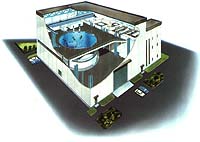 |
| Tsukuba Space Center,Weightless
Environment Test Building(WET) | On Jan. 21, 1997,
a microgravity simulation test simulating Extravehicular Activity (EVA) in space
was started utilizing the Weightless Environment Test Building in Tsukuba Space
Center. This test was intended to evaluate whether the Japanese Experiment Module
(Kibo), which is going to be attached to ISS in 2002, was designed to allow easy
repair and maintenance activities.
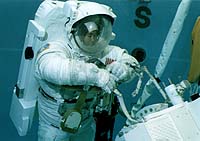 | 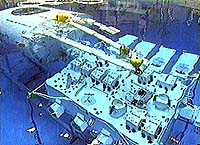 |
| Activity in neutral buoyancy environment | Kibo
mockup (EF and some portion of PM) | Unlike previously
developed unmanned satellites, Kibo is a manned space laboratory which will be
operated for over ten years. Maintenance on orbit will be conducted by astronauts.
Devices outside Kibo might require maintenance activities in a vacuum and microgravity
environment by astronauts in an Extravehicular Mobility Unit (EMU). Kibo must be
designed to accommodate such EVA maintenance activities by astronauts. This test
evaluates the design of Kibo to determine whether astronauts will have to take
difficult positions and whether they can reach the devices to be repaired or maintained.
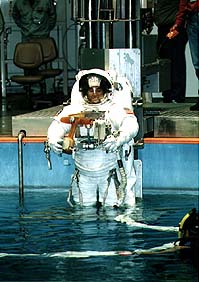 | 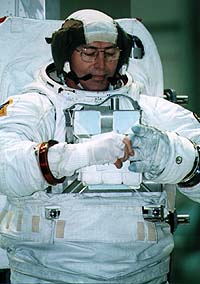 |
| Slide into water on an elevator. | Donning
a space suit. | This is the third test following similar
tests held in the US and is the first to have a NASA astronaut participate. Astronaut
Wakata and astronaut Jerry L. Ross participated in the test until the end of January.
On Jan. 21, both astronauts donned EVA suits and simulated maintenance tasks using
the Kibo mockup located in a large water pool. The two astronauts first
adjust the buoyancy of their suit to achieve neutral buoyancy in the water pool
by balancing gravity and buoyancy. They then move to the site near the Kibo mockup
to conduct evaluation activities following prescheduled procedures. The tests
this day simulated various activities such as translation along the outside of
Kibo using hand-rails or repairing the robot arm.
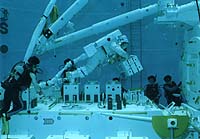 |
| Device exchange simulation |
After astronauts Wakata and Ross completed their two weeks of testing,
another group of two astronauts came to Japan and repeated similar test. Three
groups of two astronauts each, including Wakata and Ross, are scheduled to visit
Japan and conduct tests until the end of February. Identical tests are being performed
by six astronauts to ensure that Kibo was designed so that any size of astronaut
can easily conduct maintenance by EVA. When these tests are finished and Kibo's
design has been proven to have no problem, flight model production will be started.
 |
| Artist's illustration of Kibo |
The microgravity simulation tests are not only useful for designing
Kibo but they also play an important role in training Japanese astronauts. All
of the tests repeated here will mark major milestones towards ISS program completion
in the 21st century.
Last Updated : Apr. 1, 1999
| 